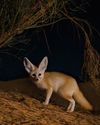BRITAIN'S LOST RAINFOREST
BBC Wildlife
|June 2022
Cool and wet, the UK is perfect for temperate rainforests, rich with rare fungi and flora. But they cover less than one per cent of the country.

THIS STORY IS A PLEA FOR the small things, those forms of life that prop up so much of our natural world, yet that we seldom notice. This is a story about lichens, mosses and liverworts.
We may be aware of these lower plants in the vaguest sense, yet for few of us do they become the focus of our attention. They came to the fore for me one day when I stood on the moors of my native Peak District and looked out on the blue-grey-green of the drystone walls stretching far into the distance.
A closer inspection of the wall beside me revealed that the blue-grey-green was not the colour of the stone at all, but of lichen. I wasn't looking at a stone wall, I was looking at miles upon miles of lichen on a stone wall.
Guy Shrubsole, writer and environmental campaigner, laughs as I describe my moment of epiphany. It is the same with trees, he tells me. "Have you ever seen tree bark? Or have you seen a covering of whatever particular lichen thrives in that area?" he asks.
"Particularly in a temperate rainforest, you're hardly seeing any tree bark; you're seeing a massive mat of mosses and liverworts and lichens, all jostling for supremacy - it is amazing!"

IT SO HAPPENED THAT TEMPERATE rainforest, a rarefied woodland habitat that is clinging on in parts of western Britain due to the (relatively) mild and wet climate, was very much on Shrubsole's mind when I spoke to him he was in the middle of writing a book about it. If the small things, such as lichens, mosses and liverworts, form the background music to much of the natural world, in the temperate rainforest that low hum bursts forth into the most wonderful orchestral crescendo of joy and delight.
This story is from the June 2022 edition of BBC Wildlife.
Subscribe to Magzter GOLD to access thousands of curated premium stories, and 10,000+ magazines and newspapers.
Already a subscriber? Sign In
MORE STORIES FROM BBC Wildlife

BBC Wildlife
"I was terrified the elephant would ram us"
African elephant in Kenya
2 mins
January 2026

BBC Wildlife
ALL YOU EVER NEEDED TO KNOW ABOUT THE Fennec fox
THE FENNEC FOX IS THE SMALLEST fox in the world, with a body length that can be as little as 24cm.
3 mins
January 2026

BBC Wildlife
INTO THE PLASTISPHERE
A unique synthetic ecosystem is evolving in our oceans – welcome to the plastisphere
7 mins
January 2026

BBC Wildlife
“More than half of all animal life exists in a parasitic relationship, and all life lives in symbiosis”
Our survival depends on species evolving to live together - but some relationships take dark turns
7 mins
January 2026

BBC Wildlife
Are animals able to dream?
SLEEP IS A MYSTERIOUS THING. FOR A long time, we weren't sure why we do it.
1 mins
January 2026

BBC Wildlife
Does a cuckoo know it's a cuckoo?
ABSURD LITTLE BIRDS ACROSS THE world lay their eggs in the nests of other species, leaving the hapless parents to raise a changeling at the expense of their own offspring.
2 mins
January 2026

BBC Wildlife
Orcas killing young sharks
Juvenile great whites are easy prey for orca pod
1 mins
January 2026

BBC Wildlife
Ocean goes on tour
Acclaimed film touring the UK, backed by live orchestra and choir
1 min
January 2026

BBC Wildlife
Feisty bats hunt like lions
Winged mammals use a 'hang and wait' strategy to take down large prey
1 mins
January 2026

BBC Wildlife
SNAP-CHAT
Richard Birchett on magical merlins, wily coyotes and charging deer
2 mins
January 2026
Translate
Change font size

